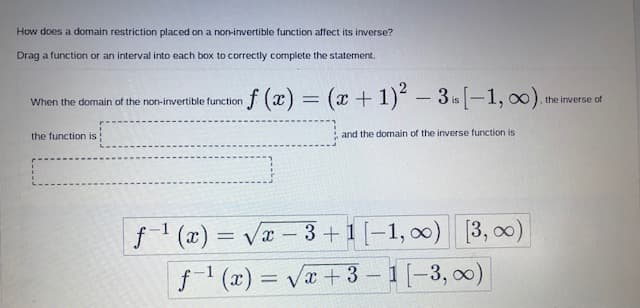Drag a function or an interval into each box to correctly complete the statement. When the domain of the non-imnveritie function f (x) = (x+1) -3 [-1, 00). ,the inverse of the function is and the domain of the inverse function is f1 (x) = Vx- 3+1 [-1, 0) [3, 0) f (x) = Va+3 - 1[-3, 0)
Drag a function or an interval into each box to correctly complete the statement. When the domain of the non-imnveritie function f (x) = (x+1) -3 [-1, 00). ,the inverse of the function is and the domain of the inverse function is f1 (x) = Vx- 3+1 [-1, 0) [3, 0) f (x) = Va+3 - 1[-3, 0)
Algebra & Trigonometry with Analytic Geometry
13th Edition
ISBN:9781133382119
Author:Swokowski
Publisher:Swokowski
Chapter3: Functions And Graphs
Section3.5: Graphs Of Functions
Problem 54E
Related questions
Question

Transcribed Image Text:How does a domain restriction placed on a non-invertible function affect its inverse?
Drag a function or an interval into each box to correctly complete the statement.
= (x+1) - 3[-1, 0).
When the domain of the non-invertible function
, the inverse of
is
the function is
and the domain of the inverse function is
f1 (x) = Va - 3+1 [-1, 0) [3, o0)
f1 (x) = Va+3 – 1[-3, 00)
Expert Solution
This question has been solved!
Explore an expertly crafted, step-by-step solution for a thorough understanding of key concepts.
This is a popular solution!
Trending now
This is a popular solution!
Step by step
Solved in 2 steps with 2 images

Recommended textbooks for you

Algebra & Trigonometry with Analytic Geometry
Algebra
ISBN:
9781133382119
Author:
Swokowski
Publisher:
Cengage

Algebra & Trigonometry with Analytic Geometry
Algebra
ISBN:
9781133382119
Author:
Swokowski
Publisher:
Cengage